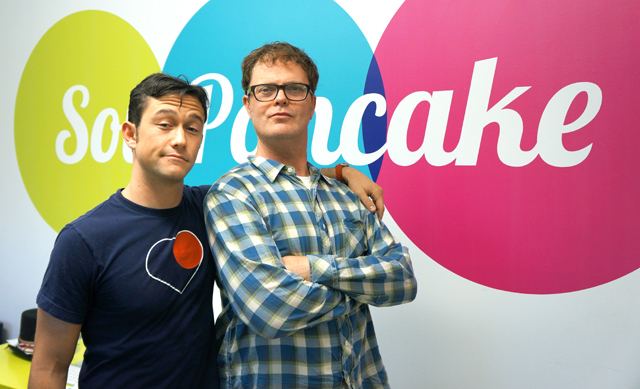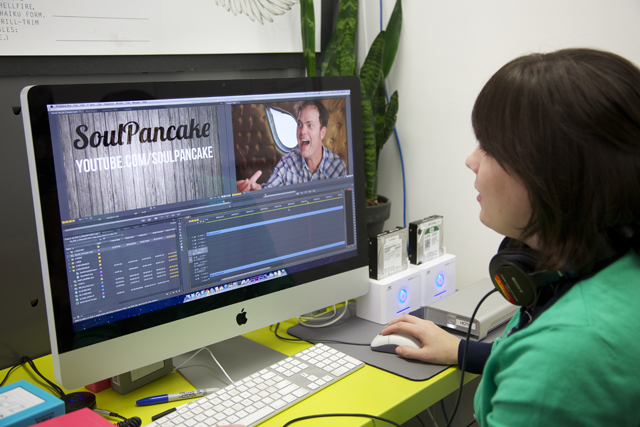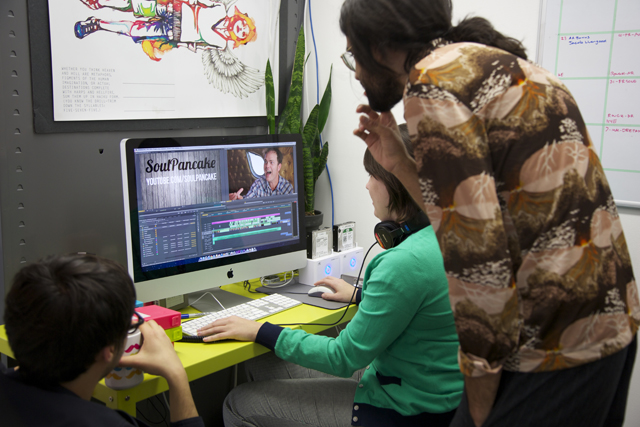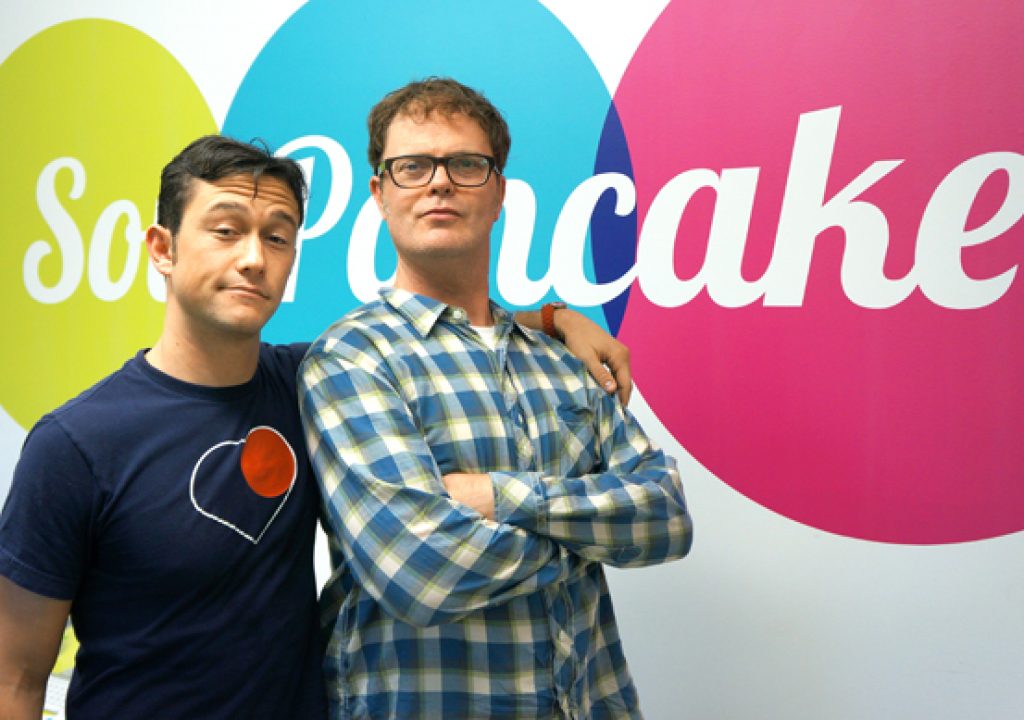SoulPancake, a production company founded by Rainn Wilson (of NBC’s “The Office”), is creating extraordinary original online video content for YouTube. With more than 100,000 subscribers and more than three million video views to date, SoulPancake ranks in the top 100 YouTube channels. SoulPancake recently switched to Adobe Premiere Pro CS6 and an all Adobe video workflow to produce its daily content, which includes series on topics ranging from art and philosophy to creativity and spirituality. Adobe had the opportunity to talk with the team at SoulPancake—including Rainn Wilson, Bayan Joonam, Shabnam Mogharabi, and Golriz Lucina about the company, inspiration, switch to Adobe Creative Cloud and Adobe Premiere Pro, and plans for the future.
Adobe: Tell us about SoulPancake, how you got started, and who is involved.
Rainn: I wanted to create a place where it would be cool again to tackle life’s big questions. SoulPancake was that place. It’s a space where people can dive into what makes us human. SoulPancake started as a website, and now we have a book, YouTube channel, and production company where we create thought-provoking, positive content and conversation around creativity, spirituality, and philosophy. We have a small core team that runs our operations, and a small staff of creative, thoughtful, hard-working individuals to help us do all of the things we do.

Adobe: What about Adobe appeals to you?
Rainn: Adobe is the ultimate creative company. Adobe tools allow you to create, imagine, and design anything you want. SoulPancake believes that art and creativity have the power to connect and bring people together from all walks of life.
Adobe: What type of content is SoulPancake creating using Adobe tools?
Shabnam: We love creating content and telling stories that are uplifting, joyful, thought-provoking, and awe-inspiring. We also strive to break people out of their day-to-day routines with fun activities and make creative documentaries that montage their experience.
Bayan: Our content seeks to open your heart or blow your mind. We focus on not only entertaining, but also engaging with the community to spark conversations that go deeper than the comment threads commonly seen on YouTube. It’s a pretty cool thing to try and do every day.
Adobe: Where do you get ideas for the mind-blowing videos you create?
Shabnam: We are inspired by literally everything and everyone! We really value creativity anywhere that we find it, so we are constantly scouring the Internet for awesomeness that might inspire a new idea. We have an incredibly creative staff that pours all their energy and imagination into helping us develop original, inspiring, and innovative content.
Bayan: We also have an army of extremely talented filmmakers who contribute their ideas and talents from around the country.
Adobe: Who is your target audience?
Shabnam: We always say that SoulPancake is for the seekers, artists, philosophers, and the curious. Your age, or gender, or ethnicity doesn’t matter.
Golriz: If you are excited by trying to figure out what it means to be human, then SoulPancake is for you.
Adobe: Tell us about your “Art Attack” series.
Golriz: Art has always been an integral part of every platform we’ve launched for SoulPancake. We knew that in order to get people digging into potentially “tough” subjects like life, death, the soul, ego etc., we needed to utilize the power of art. With “Art Attack” we aimed to create a series that showcases the incredible artistic process that often goes unappreciated. We are excited to be able to present a large variety of art genres through this series and we’re thrilled with the positive feedback we’re getting from the show’s viewers.
Adobe: What are some of your most watched videos?
Shabnam: We’ve also had a few videos cross into six figure views. Our most popular video right now is “Street Compliments,” where we setup a booth for the public to give and get compliements. That video is nearing 900,000 views. A couple of Rainn's interviews have been big hits for mixing the profound with the fun (with Joseph Gordon Levitt). And an episode on bicycling that was part of our “Subcultures” documentary series has also garnered a big viewing. That being said, two of my favorite segments that we’ve ever produced are “Unexpected Visitor,” a “FlipSide” episode that I really enjoyed as well as the premier episode of “My Last Days,” our series profiling people facing a terminal illness.
Adobe: What prompted SoulPancake to join Adobe Creative Cloud in order to switch all your in-house edit stations to Adobe Premiere Pro? How did you make the decision to switch?
Bayan: We needed software that could keep up with our strategy of releasing daily content for YouTube. We knew footage on different shows would be coming in at all different codecs and transcoding would cost up to a day at a time. Adobe Creative Cloud and Adobe Premiere Pro were the answer because they enable us to ingest any type of footage without transcoding and leverage an array of tools in the Adobe video workflow. Online video content production needs to move quickly and for multiple shows that would be delivering on a six day turnaround, one day devoted to copying files is too much time. I would rather spend that time making a good edit great.
Adobe: What was your experience like switching to Adobe Premiere Pro? What was the learning curve like?
Bayan: Seamless. We’re lucky to work with such a talented group of filmmakers such as Bobby Miller, David Monaco, Andy Golibersuch, Jacob Menache, Sama Sadeghi, and Courtney Hood who were able to quickly adapt to the program and fully utilize the Adobe workflow. It’s important to note that a software shift like this could have set us back weeks, but Adobe Premiere Pro allows editors to bring their instincts from whatever system, FCP or Avid, and start working because of handy features like cross platform keyboard shortcuts. Along the way there were some questions, but nothing that couldn’t be solved by a quick Adobe tutorial.
Adobe: What do you like most about working with Adobe Premiere Pro?
Bayan: The Adobe video workflow caters to the all-in-one filmmaker or preditor by making it easy to do it all. For example, I was on a two-day RED shoot last month that was a one man band type of gig, as are typical for YouTube. After shooting both nights I was able to directly ingest the R3D footage through Adobe Prelude, do a quick assembly of the scenes that were shot earlier that day to make sure we had all the story elements we needed. Being able to do that has made me realize that there is a lot of creative momentum lost right after you shoot to when you edit. It’s always good to put together a rough cut as soon as possible. By creating software that is allowing this type of workflow, Adobe is making way for a new type of filmmaker that we haven’t seen since the auteur days of cinema.

Adobe: How do all the Adobe video tools in Creative Cloud help you reach your goals and tell your stories with more impact?
Bayan: YouTube filmmakers are really up against every challenge possible. They have to deliver high quality content quickly with very low budgets. This fact alone forces the YouTube filmmaker to be among the most passionate and innovative forces in the industry. With that in mind, the creative momentum that you get to keep via native file support and Dynamic Link between After Effects and Adobe Premiere Pro is an incredibly useful aspect of the Adobe video workflow. Adobe video tools aren’t just helping us edit video, but also do sound, color, and graphics—in order make and maintain the highest production value on a quick turnaround. A great example is one of our weekly shows, “Art Attack.” This show has four DSLRs running video for the entirety of an artist’s process, which has been an average of eight hours, but once took up to 30 hours to complete! That's 120 hours of footage we were able to take directly into the edit and have it completed by the following week.
Adobe: What are some other Creative Cloud components that you use in your projects? Are there features that are particularly helpful in your workflow?
Bayan: We have created our backend delivery system around Adobe Prelude. We manage up to 10 shows at any given time, which are turning around a wrap book with deliverables every season (usually lasting six weeks). Every time a show delivers footage to us – media managed footage with handles/project files – we ingest the footage and have our own criteria for tagging relevant metadata through Prelude. Every season has its own Prelude project with all of that show's footage that has searchable metdata. This is especially useful, if say, an executive producer needs a clip ASAP from a series. We can get them the specific clips very efficiently.
We also use Adobe SpeedGrade, a solid color application with many of the bells and whistles I want from higher-end coloring software with an intuitive interface. Looking at the results we got from coloring DSLR footage natively from H.264 instead of ProRes 422 is shocking. Adobe Audition is also very powerful. I can’t even begin to stress how being able to easily identify and remove frequencies with a pen tool in the Spectrometer helps the quality of our productions. Often times we don’t shoot in the most ideal of locations, with traffic sounds, car horns, doors opening, cellphones going off over key moments. Adobe Audition makes it easy to save that footage so you can focus on telling the best story possible.
Recently, I've started working with Adobe Story Plus. It only took me about 10 minutes to figure out the interface and I was hooked. It includes all of the formatting shortcuts I would want from professional screenwriting software, but then adds all of the tools so that I can plan my execution strategy and easily share it with collaborators. When you’re in a situation where you are the writer and producer it can be very difficult to remember all of the details in your production. Adobe Story allows you to plan every detail of your shoot in one program, in a way that makes it incredibly easy to keep track of the logistic and creative side of production. As soon as you begin collaborating online in real time, then you really start to see the benefit. I’ve used it in a few productions, and I noticed that everyone is much more focused on what needs to be achieved on the shoot. In short, Adobe Story puts everyone on the same page.
Adobe: What is the biggest advantage of Adobe Premiere Pro vs. other NLEs?
Bayan: The commitment and dedication of the hard working staff at Adobe to continue making products on the cutting edge of creativity and innovation is what sets Adobe Premiere Pro apart. We gave ourselves a crazy mission to upload daily content. Adobe has enabled us to keep that promise.

Adobe: Tell us about your experience working with Creative Cloud.
Bayan: We’ve just started working with Adobe Creative Cloud, but we can already see how it will benefit us. We work with editors all over the country, and Creative Cloud enables us to provide access to tools no matter where our editors are located. For one of our flagship shows, “Metaphysical Milkshake,” we had an editor who needed access to Adobe Premiere Pro from a remote location. We gave him the link to log in to Creative Cloud, and within an hour he had the program downloaded and was editing. The convenience is unmatched.
Adobe: Are there any other big projects you’re working on at SoulPancake?
Bayan: We’ve created some original shorts for the Oprah Winfrey Network (OWN) and we've recently finished our pilot for OWN aimed at reinventing the Sunday morning talk show. The theme of the pilot is LOVE and all of the initial content, tests, and web content were cut in Adobe Premiere Pro and the visual effects were created in After Effects. The pilot will be on OWN Superbowl Sunday!”
Learn more about Adobe CS6 Production Premium and Adobe Creative Cloud
Download a free trial of Adobe Creative Cloud (includes After Effects, Adobe Premiere Pro, Photoshop, Illustrator, and more)

Filmtools
Filmmakers go-to destination for pre-production, production & post production equipment!
Shop Now













